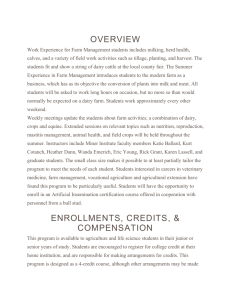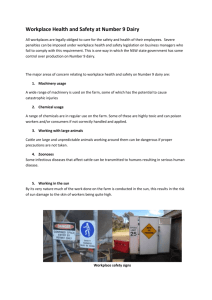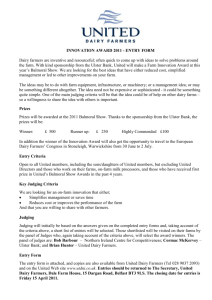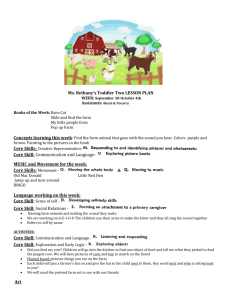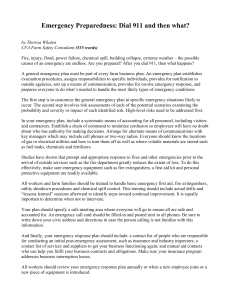Nomination Form - Dairy Farmers of Canada
advertisement
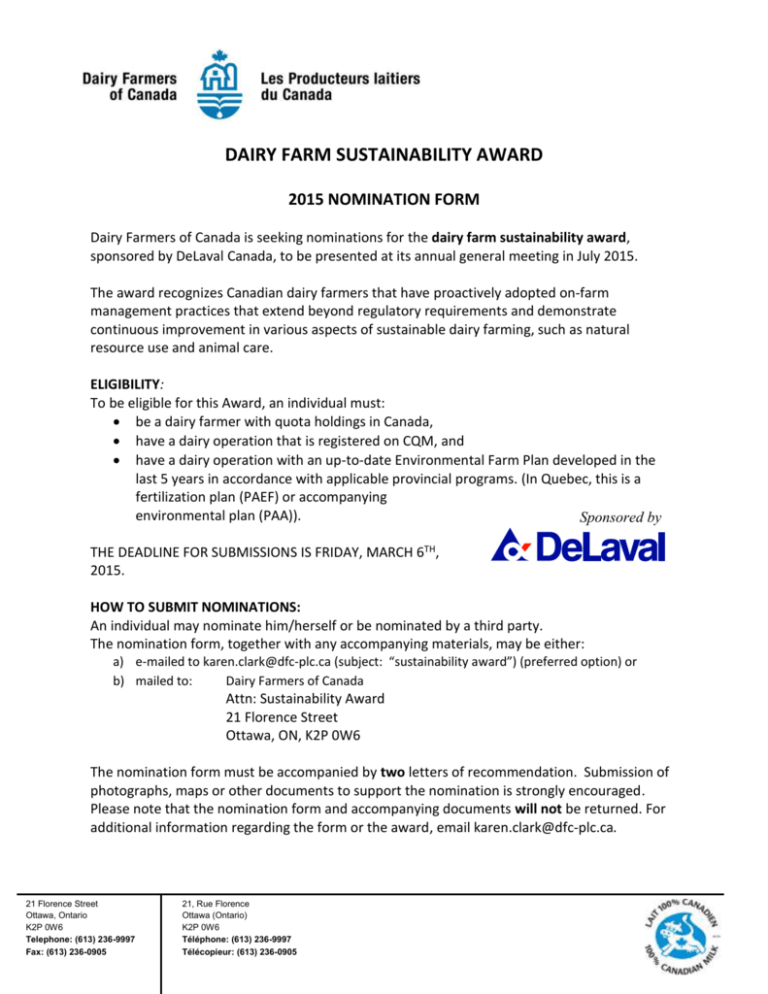
DAIRY FARM SUSTAINABILITY AWARD 2015 NOMINATION FORM Dairy Farmers of Canada is seeking nominations for the dairy farm sustainability award, sponsored by DeLaval Canada, to be presented at its annual general meeting in July 2015. The award recognizes Canadian dairy farmers that have proactively adopted on-farm management practices that extend beyond regulatory requirements and demonstrate continuous improvement in various aspects of sustainable dairy farming, such as natural resource use and animal care. ELIGIBILITY: To be eligible for this Award, an individual must: be a dairy farmer with quota holdings in Canada, have a dairy operation that is registered on CQM, and have a dairy operation with an up-to-date Environmental Farm Plan developed in the last 5 years in accordance with applicable provincial programs. (In Quebec, this is a fertilization plan (PAEF) or accompanying environmental plan (PAA)). Sponsored by THE DEADLINE FOR SUBMISSIONS IS FRIDAY, MARCH 6TH, 2015. HOW TO SUBMIT NOMINATIONS: An individual may nominate him/herself or be nominated by a third party. The nomination form, together with any accompanying materials, may be either: a) e-mailed to karen.clark@dfc-plc.ca (subject: “sustainability award”) (preferred option) or b) mailed to: Dairy Farmers of Canada Attn: Sustainability Award 21 Florence Street Ottawa, ON, K2P 0W6 The nomination form must be accompanied by two letters of recommendation. Submission of photographs, maps or other documents to support the nomination is strongly encouraged. Please note that the nomination form and accompanying documents will not be returned. For additional information regarding the form or the award, email karen.clark@dfc-plc.ca. 21 Florence Street Ottawa, Ontario K2P 0W6 Telephone: (613) 236-9997 Fax: (613) 236-0905 21, Rue Florence Ottawa (Ontario) K2P 0W6 Téléphone: (613) 236-9997 Télécopieur: (613) 236-0905 SELECTION CRITERIA: Nominations will be evaluated on each of the following areas: 1. Environmental sustainability On-farm practices have resulted in noticeable and measurable improvements in water quality or conservation, soil health, energy use, waste reduction, biodiversity, greenhouse gas reductions, or other environmental indicators. The farm has set environmental goals beyond regulatory requirements and continues to take active steps to achieve these goals. 2. Financial viability Environmental practices are financially viable over the long term (i.e. either maintain or improve economic viability). 3. Social impacts Animal health and welfare, food safety, community relations, or other societal benefits are considered on the farm. Working conditions are conducive to a safe and enjoyable workplace, and farm succession planning is in place. Promotion of on-farm practices has or can lead to improved reputation of the dairy industry. 4. Leadership and Reproducibility The dairy farmer(s) involved have demonstrated innovation and leadership. Practices are relevant to other operations and could be replicated on other farms. The farm works with agricultural or other professionals to improve environmental or social practices, and/or participates in research activities. SELECTION PROCESS: A selection committee composed of dairy and sustainability experts from academic institutions, government institutions, and other agricultural or dairy industry groups will be formed to evaluate the nominations. Finalists will be selected from the participants, and one winner will be selected from among them. The Winner will be notified a minimum of 4 weeks prior to the presentation of the prize. Nominees may not challenge the decisions of the selection committee in any way. AWARD: The Winner will receive a prize of $2000, a trophy and a trip to receive the Award in person at Dairy Farmer of Canada's annual general meeting in Vancouver, in July 2015. A video of the winning farm will also be produced. Runner-up Finalists will each receive a trophy and a prize of $1000. 2 GENERAL RULES: The Winner and each Finalist, respectively: a) consents to the use of his/her personal and other information by Dairy Farmers of Canada for the purposes of administering the Award and awarding prizes; b) grants to Dairy Farmers of Canada [and its sponsors] the unrestricted right to use and publish his/her proper name, picture, portrait, likeness, audio-video recording, interview, voice, city and province of residence, in broadcast, on Dairy Farmers of Canada’s website and other websites, in print, or any other media, in connection with the Award; and c) agrees to undertake interviews and other promotional activities organized by Dairy Farmers of Canada related to the Award, for a period of one (1) year from the granting of the Award. Nominees who do not qualify as finalists may re-apply in subsequent years. Finalists must wait three years before re-applying. The winner is no longer eligible to re-apply. 3 APPLICATION FORM Instructions: - All sections of the form must be completed. Incomplete applications will not be considered. - Include photos, maps, newspaper clippings or other supporting materials with your application that will illustrate the responses that are written below. Section 1: Farm background 1.1. Please use the following to describe the farm operation and history. - Farm is owned by: since: - Total number of cows: - Number of lactating cows: - Cattle breed: - Amount of owned land: - Amount of leased land: - Type of manure storage: - Number of employees: - Other agricultural activities aside from dairy production: (Optional) Briefly include any other information relevant to providing a historical and operational background of the farm: Click here to enter text. 1.2 Provide a short description of the ecology of the farm using the following: - soil type: - terrain: - presence of water courses: - amount of forested land: - approximate average annual rainfall: (Optional) Briefly discuss how this ecology impacts the farm and/or provide additional information on farm ecology: Click here to enter text. 1.3 Please indicate which of the following planning tools is used on the farm. For those which are not used, indicate why not (e.g. not required, not relevant, no woodlot, etc.). - Environmental Farm Plan (In QC, an accompanying environmental plan (PAA) Nutrient management plan (In QC, a fertilization plan (PAEF) Whole farm plan Woodlot management plan or FSC forest plan for harvest sustainability Wildlife habitat plan Farm succession plan Other 4 Section 2: Environmental sustainability Evaluation criteria: On-farm practices have resulted in noticeable and measurable improvements in water quality or conservation, soil health, energy use, waste reduction, biodiversity, greenhouse gas reductions, or other environmental indicators. The farm has set environmental goals beyond regulatory requirements and continues to take active steps to achieve these goals. 2.1 In the following table, briefly indicate the farm’s management goals for environmental sustainability. Indicate what steps were taken, or are currently being taken, to reach these goals, and specify what the results of the goals and/or actions have been. Where possible, provide quantitative results (e.g. $/ha saved on fertilizer; tonnes of greenhouse gases reduced; reduction of L water consumed; etc.). The categories below are provided as a guide. Where a given category is not relevant, please leave it blank, and add as many additional categories as needed. Category Management goals Steps taken Results Wildlife conservation and biodiversity Manure management Nutrient management Soil health Energy conservation or generation of renewable energy Water quality Water conservation Waste reduction Building construction Air quality improvement (including odour) 5 2.2 Indicate how the above results were monitored and evaluated. Click here to enter text. 2.3 (Optional) Provide any additional explanation and information regarding the environmental sustainability of the farm. Click here to enter text. Section 3: Financial viability Evaluation criteria: Environmental practices are financially viable over the long term (i.e. either maintain or improve economic viability). 3.1 Describe how sustainability practices or projects affected the productivity and/or profitability of the dairy operation. For example, was productivity increased? Were costs reduced? Where possible, provide quantitative examples (e.g. were able to save $/ha on fertilizer application by implementing practice X). Click here to enter text. Section 4: Social impacts Evaluation criteria: Animal health and welfare, food safety, community relations, or other societal benefit are considered on the farm. Working conditions are conducive to a safe and enjoyable workplace, and farm succession planning is in place. Promotion of on-farm practices has or can lead to improved reputation of the dairy industry. 4.1 Describe practices on the farm to maintain and improve animal health and welfare. Indicate where and how the Code of Practice for the Care and Handling of Dairy Cattle has been applied on the farm. Click here to enter text. 4.2 Describe employee relations on the farm or actions taken to improve training and/or working conditions for employees. Include, if relevant, how employees are engaged in espousing the farm’s sustainability values (e.g. animal care, environment, etc.) Click here to enter text. 4.3 Indicate the types of involvement the farm has within the local community (e.g. farm tours; presentations on sustainable practices; participation in promotional, advocacy or research activities related to sustainability). Click here to enter text. 6 4.4 (Optional) Briefly explain any other aspect of the farm’s involvement with or benefit to the local community or general society. Click here to enter text. Section 5: Leadership and Reproducibility Evaluation criteria: The dairy producer(s) involved have demonstrated innovation and leadership. Practices are relevant to other operations and could be replicated on other farms. The farm works with agricultural or other professionals to improve environmental or social practices, and/or participates in research activities. 5.1 Could the sustainable practices on your farm be replicated on other dairy farms? If so, what advice could you give to other farms trying to do so? Click here to enter text. 5.2 For the sustainable practices described in the above sections, has the farm worked with agricultural or other professionals (e.g. agronomists, dairy nutritionists, university or Agriculture Canada researchers, water specialists, nature conservancies, etc.)? If so, describe the type of interaction and how these relationships benefited the farm. Click here to enter text. 5.3 (Optional) Please provide any additional information that has not been provided above, which contributes to highlighting the sustainable practices undertaken on the nominee farm. For example: lessons learned, unanticipated benefits, meeting provincial quality awards, etc. Click here to enter text. Section 6: Letters of recommendation With the nomination, provide two letters of recommendation from outside the nominee farm. At least one letter should be from an agricultural or environmental professional such as, but not limited to, a local agronomist, dairy nutritionist, crop advisor, member of a local sustainability organization, or other advisor to the sustainability practices undertaken at the farm. The second letter may be from a neighbour, farmer, community leader or organization, etc. The letters should support the leadership and innovation of the nominee towards sustainability, by, for example, discussing the operation’s environmental practices. Please ensure these letters are signed or else sent directly from the writer. 7 Section 7: Contact information Nominee: Name Farm name Mailing address (street, city, province, postal code) Telephone Email Website Nominated by: (leave blank if farm is self-nominated) Name Title Organization Mailing address (street, city, province, postal code) Telephone Email Website Confirmation and Agreement A. Where the individual completing the nomination form is the nominee: By submitting a nomination form for this Award, I confirm that I meet the eligibility criteria for the Award and that I have read, understood and agree to be bound by the general rules of the Award. B. Where the individual completing the nomination form is nominating an individual other than him/herself: By submitting a nomination form for this Award on behalf of another individual, I confirm that I have obtained the consent of that individual, which consent is enclosed with this nomination form, and which consent states: “I understand that I am being nominated for the Award. I consent to the nomination and confirm that I meet the eligibility criteria for the Award and that I have read, understood and agree to be bound by the general rules of the Award.” 8


